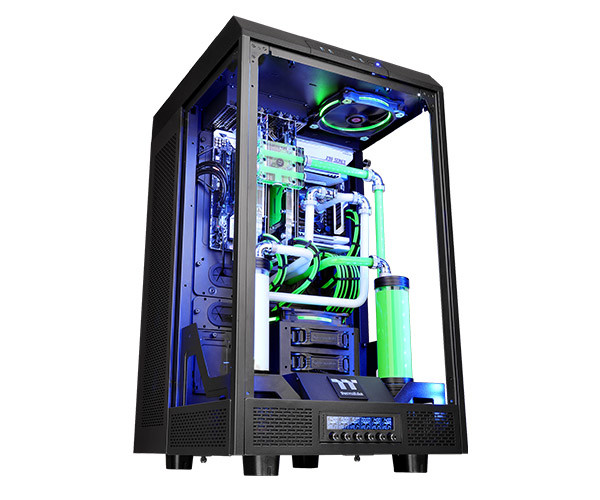▷ Types of tower, chassis or case for pc: atx, micro atx and itx

Table of contents:
- The different types of PC chassis, characteristics of each
- Small Form Factor or Small Form Factor (Mini-ITX)
- Mini Tower or Mini Tower (Micro-ATX)
- Half Tower or Mid-Tower (ATX)
- Full tower or full tower (E-ATX)
- Which chassis is best for me?
With a little online search we will see that there are many different types of chassis or PC cases available in the market. These different types of chassis offer their own advantages and disadvantages, and are also capable of fulfilling different functions because they come equipped with differentiating features. In this articles we analyze the main types of PC chassis. Tower, chassis or PC case types.
Index of contents
The different types of PC chassis, characteristics of each

Knowing the difference between different PC chassis will help you decide which one will meet your usage needs. The most common type of system chassis is the tower. Depending on the specific number of internal drive bays and tower height, these chassis can be classified into small size, medium size, and tower size cases. One of the most important considerations when choosing between sizes is the number of slots and the number of devices we would like to add to these boxes. This type of chassis is considered the most basic. It is what is seen most often in homes and offices and offers the most basic functions. Its main purpose is to keep all the internal components inside the box to maximize the space provided.
These tower chassis can be classified into four variants: Mini-ITX, Micro-ATX, ATX and E-ATX. We summarize the most important characteristics of each of them.
Small Form Factor or Small Form Factor (Mini-ITX)

This type of box is the smallest in the family. It can only support a Mini-ITX motherboard (17cm x 17cm), which means it offers very few motherboard options. It is very small and compact, a feature that has its own advantages and disadvantages. Small means it only has two expansion slots, but it also means it is very portable making it the preferred chassis for gamers who like to attend events.
Mini Tower or Mini Tower (Micro-ATX)

Many users want their computers to be easily transportable, but at the same time they do not want to sacrifice their expandability, for them the mini tower was created. This design can support a Mini-ITX or Micro-ATX motherboard (24cm x 24cm) and has four expansion slots. This gives it an advantage over the SFF because it is still mobile enough, but not as limited as the latter. Its size is between 30 and 45 cm
Half Tower or Mid-Tower (ATX)

It is probably the most common and preferred type of tower box by users. It supports Mini-ITX, Micro-ATX and ATX motherboard type (30cm x 24cm) and has 7-8 expansion slots, depending on the brand. This tower also features the cable management option, making it a hit with builders who naturally prefer to keep their equipment tidy and organized. Although not as portable as the first two tower types, this is the PC chassis preferred by many gamers, because it can fit high-end graphics cards and still leave room for other expansions. Its size is between 45 and 60 cm
Full tower or full tower (E-ATX)

This is the tower type option for competitive players and server administrators worldwide, due to its many features and its ability to host up to 10 expansion slots. It is also compatible with the four different types of motherboards: Mini-ITX, Micro-ATX, ATX and EATX, making it very versatile.
Due to its ability to store a large number of internal components, a complete tower case tends to be very heavy, making it difficult to transport. While you can push the limits of your PC with this case, you should pay attention to its cooling capacity, because such a large chassis can easily overheat if the airflow design is not well designed. They get to measure more than 75 cm.
Which chassis is best for me?
This is a question that only you can answer, in this article we have given you the most important characteristics of the different types of PC chassis, now you have to decide what is your priority and from there make a decision. If you want equipment that is very bulky, lightweight, and easily transportable, a Mini-ITX chassis should be your choice.
The ATX format is the most popular among users, including demanding gamers, offering an excellent balance of dimensions and ability to accommodate components. Its larger size will also help prevent hardware overheating, as it won't turn into an oven as quickly as a Mini-ITX chassis with very powerful hardware.
The E-ATX format will be the preferred format for those who want to install a custom liquid cooling system, since its large capacity will not limit us when it comes to installing the elements that make it up.
This ends our article on types of towers, chassis or PC cases, you can leave a comment if you have any suggestions or something to add.
Thermaltake tower 900 e 'mega-tower' announced

One of the major manufacturers of hardware and peripherals has just introduced its new Thermaltake Tower 900 E-ATX towers.
▷ Types of motherboards: at, atx, lpx, btx, micro atx and mini itx

This article we will see the different types of motherboard ✅ as well as their most important characteristics: ATX, E-ATX, mATX, Mini ITX ...
Micro atx motherboard: is an atx better than an itx?

If you have not yet decided between buying a micro ATX or ITX motherboard, here we will see the advantages and use of each of them




